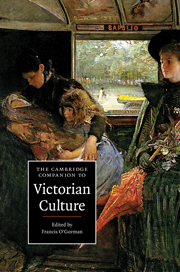14 - The dead
Published online by Cambridge University Press: 28 July 2010
Summary
'Dead', Charles Dickens's narrator says after the demise of Jo the Crossing Sweeper in Bleak House (1852-3) and 'dying thus all around us, every day'. Dickens helped make Victorian death seem like a way of life. His celebrated death scenes - Jo, Paul in Dombey and Son (1846-8), Little Nell in The Old Curiosity Shop (1840-1) - assisted in propelling the notion of a Victorian 'sentimental' investment in death. For many decades afterwards, the Victorians have seemed to have had a peculiarly intimate relationship with, even a readiness to celebrate, mourning. The major new cemeteries - Highgate and Kensal Green, for instance, or the cemeteries of Birmingham, Leeds and Sheffield - were solemn but strangely to be enjoyed. Queen Victoria, losing Prince Albert in 1861 (perhaps to stomach cancer finished off by pneumonia or typhoid) retreated into grief. A Queen in mourning, she seemed to preside symptomatically over a culture - with its new great burial sites, notorious infant mortality rates, industrial accidents, stark gaps between rich and poor and elaborate rituals of the grave - that knew death more familiarly than any modern period. It was an age of elegy. The Queen's favourite Laureate, Alfred Tennyson, was best known for In Memoriam (1850), his lament on the death of his friend Arthur Henry Hallam. Even the first postage stamp was black.
- Type
- Chapter
- Information
- The Cambridge Companion to Victorian Culture , pp. 255 - 272Publisher: Cambridge University PressPrint publication year: 2010
- 2
- Cited by



